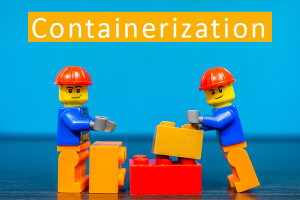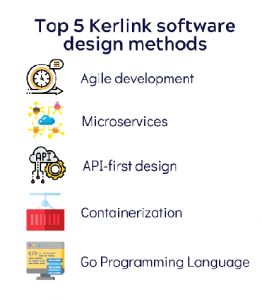The untold story: how Kerlink’s mastery of software-development best practices delivers critical benefits to customers. Part 4, Containerization

By Stephane Dejean – Kerlink CMO
Part 4 of our five-part series explains how Containerization is the ideal support vehicle for Kerlink’s microservices-based architecture to maximize infrastructure efficiency, while accommodating business changes and growth.
Kerlink is widely recognized for its highly reliable connected hardware and for the quality, robustness and all-around performance of its Wirnet LoRaWAN network-infrastructure solutions. Kerlink was the first provider of commercial, carrier-grade gateways and recently extended its premier industrial-grade iSeries with new indoor and outdoor products.
As a full-service, turnkey Internet of Things (IoT) solutions provider, the company also offers proven quality software development. With particular expertise in network management & orchestration solutions and value-added services such as geolocation and remote device management, Kerlink has more than 120,000 installations with more than 330 clients in 69 countries. The quality of its software is increasingly being recognized by demanding and experienced industrial users.
The selection, adoption and mastery of software-development best practices drive Kerlink’s business model and the richness of its service portfolio.
Not only are these IoT solutions perfectly synchronized with the latest LoRaWAN specifications, they also leverage the flexible, efficient and open methods of software design and management to meet the scalability, security and usability requirements of Kerlink’s customers worldwide.

The series:
- Method 1: Agile Development – March 19
- Method 2: Microservices – March 26
- Method 3: API-first Design – April 2
- Method 4: Containerization – April 9
- Method 5: Go Programming Language and Direct Benefits to Customers – April 16
In this five-part series, we will explain our top software design & development methods that benefit our customers and show that the company is at the forefront of software design, development methods and architectures.
Part 4: Containerization
Containerization is a set of products that allows software, associated libraries and configuration files to be delivered in bundles or containers. Containerization leverages free software and professional support (e.g., Docker, Kubernetes and others) to deliver a software application in images that can be hosted and run independently in any operating environment (i.e., servers or containerization services like “CaaS”).
Enterprise use of containerization is expected to continue to grow.
“By 2022, 70% of new enterprise IoT applications built on IoT platforms will leverage container deployment” – IDC (1).
Furthermore, IDC recommends that enterprises have a cross-functional team to research and understand container orchestration platforms and ultimately make IoT platform decisions.
Kerlink has found that containerization, because it is both a packaging technology and an execution environment, is the ideal support vehicle for its microservices-based architecture to maximize infrastructure efficiency while accommodating business changes and growth. Kerlink uses containerization and recommends the same for its customers, as this provides a high level of flexibility for application design, development and support and helps to reduce time-to-market.
Time- and Cost-savings Tool
Containerization makes it possible to install and launch an application irrespective of the underlying platform and infrastructure selected, including hosted services, public cloud, private cloud, physical hardware or virtual hardware, with no lock- in and providing enterprises the ability to change infrastructure deployment model. Finally, in order to ensure that Kerlink customers can focus on the criticality and usability of their applications rather than implementation issues, Kerlink supports the use of containerization as a time- and cost-savings tool to deploy its software solutions, like its IoT network management and operations suite, Wanesy Management Center.
Containerization technology is an essential step in further virtualizing the delivery of software solutions. Incorporating containerization technologies like Docker and Kubernetes, through a set of open-source tools, automates the deployment, activation, orchestration and scalability of application containers on server clusters.
Kerlink continues to improve the quality and innovation of its design, the relevance of its technological choices and the industrialization of its methods and solutions.
All of these decisions lead to great benefit to customers for their quick onboarding and in their daily use of Kerlink technology.
Hardware & Software that ensure Interoperability throughout the IoT chain
The choices made in Kerlink’s methods, architectures and support tools illustrate the company’s maturity and innovation in software design, deployment management and operations management in highly demanding customer environments. Kerlink believes in providing open, interoperable and reversible solutions matched to industry standards to provide exceptional customer experience and ensure the ongoing development of its solutions to support customers’ growing and evolving businesses.
Kerlink’s hardware and software expertise ensures interoperability of all functional components of the IoT chain, including embedded gateway software and server-side applications. Customers have come to rely on Kerlink’s expertise in the design of infrastructure and applications to support IoT network management and low-power wide-area (LPWA) private and public networks, in particular.
Continuous Production Releases
Kerlink’s choice of agile development, microservices architecture, API-first design, containerization and Go programming language has strengthened Kerlink’s IoT solution-development efforts. And we have shared these benefits with our valued customers by providing the ability to deploy a Kerlink solution in minutes, minimize risks throughout IoT solution-operations management, control IoT solution costs at a refined level and decrease deployment time.
By allowing continuous production releases, Kerlink enables its customers to benefit from rapid advancements in applications, management tools and platforms. These advancements improve the speed at which enterprises can design, deploy and support their IoT solutions. A software-design framework allows Kerlink to develop a set of automated operations tools to foster fast, reliable and flexible delivery of solutions for its customers.
Next week: Go Programming Language
(1) Source: “IDC FutureScape: Worldwide 2020 loT Predictions.” IDC, December 2019.


